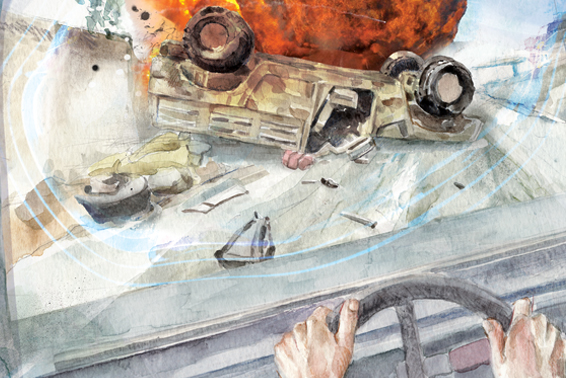From the Department of Mounties at War
RCMP officer Wayne Martin’s job in Afghanistan
was to train Afghan police forces, but when a
suicide bomber hit his convoy, he became
an eyewitness to the death of diplomat Glyn Berry,
and the tragic aftermath.
I am originally from Windsor, Ont. When I was young, I had an interest in law enforcement and I saw the RCMP as an opportunity to do something interesting. I joined the force in 1974.
In 2005, I heard rumblings about an Afghanistan mission standing up from Bob Hart, a friend of mine. And that’s how I got to go. Hart and I were the first RCMP into Kandahar, attached to the Provincial Reconstruction Team (PRT). Our role was to do a needs assessment—what did the Afghan National Police need and what could we do to help? It quickly became apparent that what they needed was everything: there were guys doing foot patrols in flip-flops and carrying an AK-47 with three rounds in the magazine.We ran courses and taught things like arrest methods and catastrophic first aid, such as what to do if a leg gets blown off, because that was the environment we were dealing with.
On the day we got hit, the mission was to visit a small town not that far away. It was Glyn Berry’s mission. As the political director for the Department of Foreign Affairs with the PRT, he was going to discuss the political climate: are they leaning Taliban or are they leaning government? It was Sunday, Jan. 15. We left the PRT at about 9 a.m. We arrived OK, but there weren’t many people around for some reason. That was fine. We left there around 11 and went to Kandahar Airfield to do some administrative stuff. I still remember waiting to leave. Glyn was leaning on his vehicle, having a hamburger, and we were chatting. Just a normal day.
We mounted up. It was a four-vehicle convoy to go back to the PRT. Glyn’s vehicle was second and mine third. It was always a little chaotic and nerve-racking in that area. I was looking left and my vision literally just returned to the front as the explosion occurred. All I saw was a big red and orange fireball and then dark black smoke. Then a concussive wave hit me.
My driver went through the debris field. We were right in it, maybe 20 metres behind the impact. As we drove through, I could see the G Wagon that Glyn was in, driven by Master Corporal Paul Franklin, doing a barrel roll off to the left. The radio started going crazy at this point. The military guys jumped out and the officer said to me, “You stay here and provide security.” RCMP didn’t have rifles at that point, so I was out there with my 9mm, “providing security” and looking back to see what was happening. I could tell they were administering first aid.
The officer came back to radio the situation in. That’s when he looked at me and said, “Berry’s gone.” We got back to the PRT as fast as possible to get treatment to the wounded before they were airlifted to Kandahar Airfield. When the helicopter came in to pick up Franklin, he was taken out on a stretcher. There was somebody walking behind with a green garbage bag, and we all knew what was in it: his leg.
And that’s how a green garbage bag became my most searing memory of the war in Afghanistan.
Advertisement













